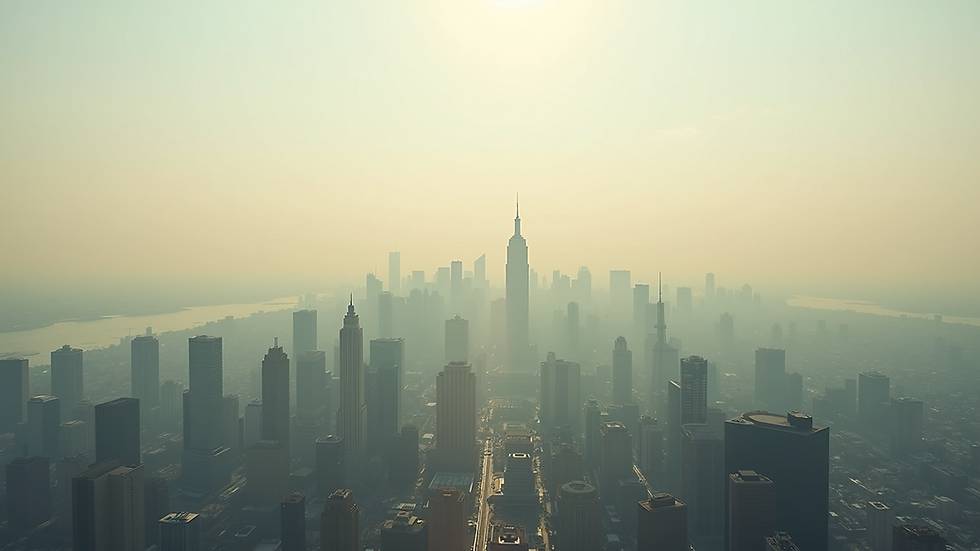Air Quality Alert in New York: What You Need to Know for Safety
- edu.plus.weatherray Rome
- Aug 3
- 3 min read
As residents of New York brace for an Air Quality Health Advisory, it's important to understand its implications for our health and daily routines. The New York State Department of Environmental Conservation has issued an alert effective from midnight tonight until midnight EDT on Monday night, indicating elevated levels of fine particulates in the air.
Air Quality Index (AQI)
The Air Quality Index, or AQI, is a vital tool for assessing air quality. It communicates how polluted the air is currently and indicates potential future pollution levels. The AQI includes various pollutants such as ground-level ozone, particulate matter, carbon monoxide, sulfur dioxide, and nitrogen dioxide.
The AQI scale ranges from 0 to 500, categorizing air quality into six distinct levels—from "Good" to "Hazardous." For instance, an AQI value above 100 for fine particulates highlights a moderate to unhealthy air quality, raising concerns primarily for sensitive groups. In fact, studies show that when the AQI exceeds 150, respiratory problems can increase by 30% among vulnerable populations, underscoring the urgency of these advisories.

Who Should Be Concerned?
While everyone should heed this warning, certain groups are particularly at risk. Children, the elderly, and individuals with pre-existing health conditions—such as asthma or heart disease—are more vulnerable. The New York State Department of Health recommends that these individuals limit strenuous outdoor activities during this period. For example, studies suggest that children can experience shortness of breath or coughing at AQI levels above 150.
If you or someone you know experiences symptoms like wheezing or chest tightness, seek advice from a healthcare professional. Staying alert to air quality can significantly empower you to protect your health.
Safety Recommendations
To protect your health during this advisory period, consider these practical suggestions:
Limit Outdoor Activities: Postpone outdoor sports or gardening and opt for indoor exercises instead, like yoga or body-weight workouts, which can be done in well-ventilated spaces.
Stay Informed: Monitor local air quality updates. For example, fine particulate levels can surge with changing weather conditions or increased urban pollution. Utilize resources such as the New York State Air Quality Index for timely updates.
Use Air Purifiers: If available, operate your air purifier to filter out harmful particles. Keep windows closed to limit outdoor air from entering your home.
Consider Your Vulnerability: Pay special attention if you belong to a sensitive group. Limit your time outdoors and monitor any health changes closely.
Hydrate: Staying hydrated won’t clear the air, but it helps your body flush out pollutants more effectively.
What Causes Fine Particulates?
Understanding the origins of fine particulates is crucial for recognizing how they affect air quality. Fine particulates, or PM2.5, are particles smaller than 2.5 micrometers that can travel deep into the lungs. Common sources include:
Vehicle Emissions: According to the EPA, transportation accounts for about 29% of greenhouse gas emissions in the U.S., a significant contributor to urban air pollution.
Industrial Discharges: Factories release various pollutants, elevating fine particulate levels and affecting air quality across neighborhoods.
Natural Sources: Events such as wildfires and dust storms can dramatically increase fine particulate levels. For instance, during the 2020 California wildfires, AQI levels soared above 200 in surrounding states.
Weather Conditions: Certain weather patterns, like temperature inversions, can trap pollutants closer to the ground, worsening air quality.
Knowing these sources aids personal safety measures and can spur community advocacy for stricter air quality regulations.
Resources for Staying Safe
Residents can utilize several resources to navigate this air quality advisory effectively:
New York State Department of Environmental Conservation (DEC): Their website offers the latest updates and educational resources on air quality.
Air Quality Hotline: If you have questions about air quality, call the Air Quality Hotline at 800-535-1345 for assistance.
By staying informed and taking sensible precautions, residents can protect their health during these periods of poor air quality.

Take Action for Your Health
An Air Quality Health Advisory can be alarming, especially for those vulnerable to pollution's effects. Understanding what this alert entails, knowing who it affects, and learning how to safeguard yourself is crucial.
Make sure to limit outdoor activities, stay informed through available resources, and check in with healthcare professionals if you experience any concerning symptoms related to air quality. By prioritizing safety and taking proactive steps, we can face these alerts with greater resilience.
Let’s work together to stay informed and advocate for cleaner air in our communities. Our collective efforts can help diminish pollution levels and protect our health for the future.



Comments